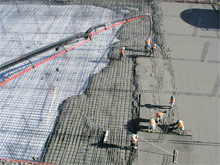A Nova Scotia company could soon be revolutionizing the concrete industry by making the building blocks of the urban environment a little greener.
Robert Niven, a chemist and environmental engineer, is the president of the Halifax-based company Carbon Sense Solutions Inc.
The company has developed a system that uses carbon dioxide waste gases emitted during the production of pre-cast concrete as valuable feedstock for the concrete curing process itself.
Pre-cast concrete normally requires high volumes of steam to cure - or strengthen and harden, the concrete. But Carbon Sense Solutions is using the innovative idea of combining mitigation measures for greenhouse gas emissions with cost-savings for producers and quicker curing process.
The technique recently went through a proof-of-concept phase and is beginning a pilot program in rural Nova Scotia this year.
Niven is going after a large market. Analysts estimate the worldwide pre-cast concrete market is worth $125 billion a year and is growing. It's also a large contributor to greenhouse gas emissions worldwide.
"It's a big fish in the world of greenhouse gas mitigation," Niven said.
Niven calls the use of carbon dioxide in curing concrete a type of "industrial symbiosis."
"CO2 is actually consumed in the concrete during the curing process of pre-cast concrete products," Niven said.
If Niven's process works, a one kilogram block of pre-cast concrete could contain as much as 500 grams of carbon dioxide stored as a solid as the CO2 is converted to calcite during curing.
Niven said that eliminates the problems of other forms of carbon sequestration, such as storing the gas underground.
The Carbon Sense Solutions technique makes sense because it effectively "closes the loop" in an industrial process that releases large amounts of carbon dioxide during production.
"There's no way around it. Making concrete is a chemical process that releases CO2," Niven said. "We're returning that CO2 to the concrete."
Carbon Sense Solutions is continuing to test and refine the process and is generating interest around the world. Niven is getting inquiries from India, England and Brazil. He said the process has the potential of putting away 500 megatons of CO2 annually.
A consultant with a reputation for helping industry and governments deal with the thorny issue of carbon sequestration, Niven believes this process only needs to be proven for the concrete giants of the world to change the way they operate.
"It's simple and fast and has substantial energy savings," he said.
With the company working on developing a pilot factory in Lantz, N.S. and interest industry and governments, Niven said the technology could make Nova Scotia a leader in carbon capture and storage.
"We're at the epicentre of carbon sequestration," he said.

